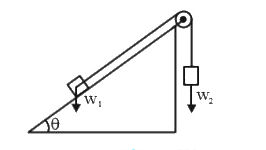The cathode of a photoelectric cell is changed such that the work function changes from (W1→W2(W2>W1). If the current before and after change are I1 and I2, all other conditions remaining unchanged , then (assuming hv>W2)
I1 = I2
I1<I2
I1>I2
I1<I2<2I1
The correct Answer is:A
To solve the problem, we need to analyze how the change in work function affects the current in a photoelectric cell while keeping other conditions constant.
1. Understanding Work Function: The work function (W) is the minimum energy required to remove an electron from the surface of a material. In this case, we have two work functions: W1 (before the change) and W2 (after the change), with W2 > W1.
2. Photoelectric Effect Condition: The condition given is that the energy of the incident photons (hv) is greater than W2. This means that the photons have enough energy to emit electrons from the cathode even after the work function has increased.
3. Current in the Photoelectric Cell: The current (I) in a photoelectric cell is directly proportional to the number of electrons emitted from the cathode. The number of emitted electrons depends on the intensity of the incident light, not on the work function or frequency, as long as the energy of the photons is sufficient to overcome the work function.
4. Intensity and Current Relationship: Since the intensity of the incident light is unchanged in this scenario, the number of emitted electrons remains constant. Therefore, the current before the change (I1) and after the change (I2) will be the same.
5. Conclusion: Since all other conditions remain unchanged and the intensity is constant, we conclude that:
I1=I2
Final Answer:
Thus, the current before and after the change in work function will be equal:
I1=I2
I1=I2
Thus, the current before and after the change in work function will be equal:
I1=I2
Similar Questions
Ultraviolet light is incident on two photosensitive materials having work function W1 and W2(W1>W2). In which case will the kintic enrgy of the emitted electrons be greater? Why?
View SolutionA gas is expanded to double its volume by two different processes. One is isobaric and the other is isothermal. Let W1 and W2 be the respective work done, then find W1 and W2
View SolutionIn the accompanying diagram W1 is 5kg weight and W2 is 3 kg weight. If the component of W1 parallel to the incline is equal to W2, then the angle θ is nearly :

View SolutionTwo weights W1 and W2 in equilibrium and at rest, are suspended as shown in figure. Then the ratio W1W2 is :

View SolutionA body of weight w1 when floats in water displaces an amount of water w2. Then w1<w2. In this statement true or false?
View SolutionIf i1=3sinωtand(i2)=4cosωt, then (i3) is

View SolutionW1,W2 and W3 are the different sizes of windows 1,2, and 3 respectively placed in a vertical plane. A particle is thrown up in the vertical plane. Let t1,t2 and t3 are the time taken to cross the window W1,W2 and W3 respectively and ΔV1,ΔV2 and ΔV3 are the change in speed after respective window cross.

View SolutionPlot a graph showing the variation of stopping potential with the frequency of incident radiation for two different photosensitive having work functions W1andW2(W1>W2) . On what factors does the (i) slope and (ii) intercept of the lines depend ?
View SolutionA given mass of a gas expands from the state A to the state B by three paths 1,2 and 3 as shown in the figure, If W1,W2 and W3 respectively be the work done by the gas along the three paths then

View SolutionThe work done in moving a particle in the gravitational field of earth from point A to point B along three different paths 1,2 and 3 are W1,W2 and W3 respectively , then

View Solution
